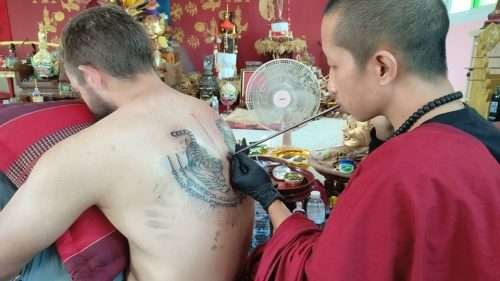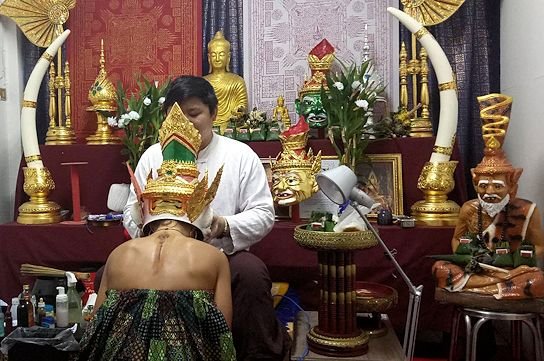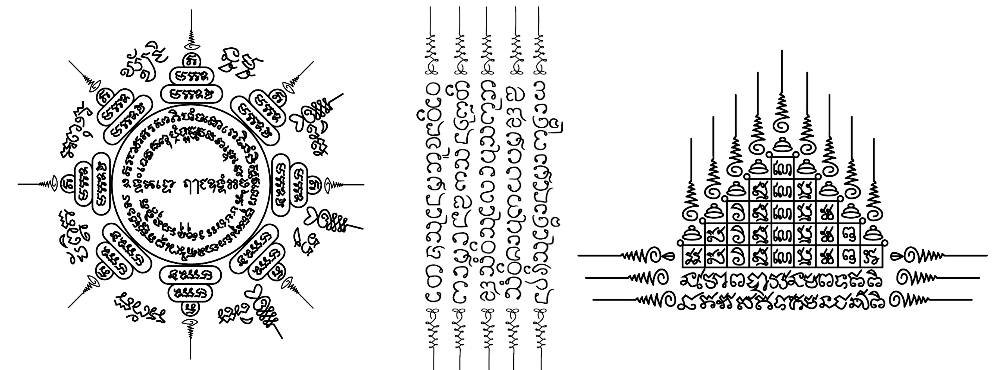What is a Sak Yant Tattoo?
Understanding What is a Traditional Thai Tattoo?
Understanding the Traditional Thai Sak Yant Tattoo
What is a Sak Yant | Explanation of Sak Yant Tattoo
The Sak Yant Tattoo is a Traditional Thai Tattoo that has both Spiritual and Cultural Significance. The Sak Yant is applied by a Master (holy man) using the Hand Poke method with a Steal Needle. An Authentic Sak Yant requires
1) Opening Offering to the Master and Tradition
2) Personalized Magical Text
3) A Magical Blessing to charge the design
The Sak Yant Tattoo offers protection to the wearer and serves as a Talisman of Affirmation for a personal quality, quest or goal.
Sak Yant Tattoos are a traditional form of tattooing that originated in Southeast Asia. They are also known as Yantra tattoos or Traditional Thai Tattoos, Monk Tattoos, and are deeply rooted in the spiritual and religious beliefs of the region. In recent years, these tattoos have gained popularity across the world, with many people getting them as a form of body art or as a symbol of their spiritual beliefs.
In this article, we will explore what a Sak Yant tattoo is and compared to a Fake ‘Bamboo tattoo’ promoted by normal tattoo parlors), its history, meaning, and how to get one.
Table of Contents
ToggleWhat is a Sak Yant Tattoo?

A Sak Yant tattoo is a traditional form of tattooing that originated in Thailand, Cambodia, Laos, and Myanmar firsts by a Holy men and later Buddhist Monks. The word “Sak Yant” translates to “magic tattoo” or “blessed tattoo” in Thai. These tattoos have to be made by Buddhist Monks or spiritual masters (called Sak Yant Masters or Ajarns), who have undergone years of training and practice.
Sak Yant tattoos are believed to have magical powers, which can protect the wearer from harm, bring good luck, and ward off evil spirits. They are also thought to enhance the wearer’s physical and mental abilities, such as strength, courage, and wisdom.
The tattoos are usually made up of intricate designs and symbols, which are believed to have different meanings and powers. Some of the most common Sak Yant designs include the Hah Taew (Five Line), Gao Yord, (9 Peaks) and Paed Tidt (8 Direction)
The 3 Parts that make a Real Sak Yant Thai Tattoo
1) The Sak Yant Tattoo Design
The most familiar part of knowing what is a Sak Yant Tattoo – This is the picture or design of the Sak Yant.
While all Sak Yants come with their own meaning implicit to the design, if you like a certain design, it might be able to be used but changed to include the Kata and Blessing elements into the final meaning.
There are hundreds of different Sak Yant Designs from many different lineages (or schools) of Sak Yant Tradition.
2) The Sak Yant Tattoo Khata
This includes the magic spells within the mind of the Sak Yant master as they create the Sak Yant. The master is reciting special prayers as they apply the design so that it becomes filled with the desired intention of the final design.
The Kata also includes the text written around the Sak Yant. This text is usually presented incorrectly in drawn images you find online and are corrected by the Master. This is design to keep the knowledge so that only those qualified to give Sak Yants can give them.
3) The Sak Yant Tattoo Ritual
An offering is made at the beginning of a Sak Yant to honor the Master and the Tradition.
A final blessing given at the end of the Sak Yant Process. Special intentions and desires can be requested for this. The Blessing of the Sak Yant can only be done by an Authentic Sak Yant Master trained in the magical arts.
Without the ritual from a real Sak Yant Master (of which Tattoo shop Artists are not) – you do not have an authentic Sak Yant Tattoo
Meaning of the Term Sak Yant - สักยันต์ -

The term Sak (สัก in Thai) means to ‘Tap’ or ‘To Tattoo’. Traditionally done with a Bamboo Needle, hence the combination of ‘Tap Tattoo’
The term Yant (ยันต์ in Thai) means ‘Yantra’. Originally derived from the same Sanskrit word a Yantra or Mantra is the magical design and Text.
Sak Yant Tattoo are the Thai name for the Tattooing of Sacred geometrical designs on the skin. Yant (or Yantra, as they are call them in the west), can only to be tattooed by Buddhist monks, or Brahmin Holy men.
The Yant tattoos have developed over the centuries under the influence of several different religious philosophies. The Yantra designs that already existed in Hindu India were adapted by the Thais as Buddhism arrived from neighboring India.
History and Origins of the Sak Yant Tattoo
The origin of sak yants can be traced back up to 2000 years ago, although the oldest known record of its use dates back only to the 1600s, during the reign of the Ayuttaya Kingdom in Thailand. Warriors were bestowed with yant tattoos and yant shirts as a talisman to safeguard them in battle. The yantra tattooing process was conducted by monks through a traditional hand-poked technique using a Steel tool called a Khem.
As the Sak Yant is very popular in Thailand, they are sometimes referred to as the Traditional Thai Tattoo, and in Cambodia as a Khmer Tattoo. No real Sak Yant Master however refers to them as a Bamboo Tattoo. This term is a recent Tourists Scam by Tattoo Shops to gain extra income by providing replicas to gullible tourists.
For detailed information you can read History of Sak Yant Tattoos
Cultural and Spiritual Significance of Sak Yant Thai Tattoos

The Traditional Thai Tattoo (or Sak Yant Tattoo) hold a deep cultural significance in Thailand. The Traditional Thai Tattoos are deeply rooted in Thai Buddhism interpreted from Hinduism, and are often seen as a way to connect with magical powers, spiritual forces and gain blessings.
Sak Yant Tattoos can bring good luck, health, and prosperity to the wearer. The designs are often accompanied by special prayers and blessings, which are said to imbue the tattoo with spiritual energy. With the increased popularity of Sak Yant’s many tattoo parlors and artists offer fake replicas of the designs.
This is not only considered highly disrespectful to the culture and traditions of Thailand. The placing of fake Sak Yants obtained from tattoo shops could result in a Real Sak Yant Master refusing to give an authentic Sak Yant due to the lack of respect for the spiritual aspects of the Sak Yant history and traditions.
What is the Purpose of a Sak Yant Tattoo?
A Sak Yant Tattoo purpose is seen as the strongest form of protection against bad luck, black magic and supernatural forces. The primary meaning of Sak Yant Tattoos are used as a magical form of protection against negative influences of ones life. In addition to the supernatural protection they are used as a personal Talisman for creating change in personality traits, life circumstances and assistance in the achievement of goals.
For the wearers of the Sak Yant Tattoo, the Sak Yant does have an important part to play in obtaining assistance in life through the benefit of receiving the positive Karma from the Monk or Sak Yant Master who creates it. In Thai culture as well as many religions around the world, the ability of a spiritual master to share/bless/charge the spiritual status of another is accepted as a matter of reality. The Sak Yant Tattoo then, bestows spiritual and magical power to the user from the knowledge and wisdom of the Master. This is Why you don’t get a Sak Yant Tattoo from a Tattoo Studio
Sak Yant Tattoo Protection Against
Dangers
Illness
Unwanted Spirits
Bad Luck
Physical Harm
Black Magic
Spells & Curses

Sak Yant Tattoo Personal Qualities
Invincibility
Good fortune and Luck
Avoid bad Habits
Attraction and Charisma
Power and Authority
Overcome Opponents
Comparison and Kindness
The Master Traditional Thai Tattoo's - The 3 Most popular Sak Yant Designs

The Master Yants contain univerisal blessings that cover everything. They are
1) Paed Tidt (8 Direction)
2) Hah Taew (Five Line)
3) Gao Yord (Buddha Peaks)
Other, more complex and complicated Sak Yant designs such as animals and sacred geometry are seen as advanced talismans for more serious and dedicated believers. I For more extensive details of various Sak Yant designs you can check out the article “Sak Yant Designs and Meanings”
Choosing Your Sak Yant Design
Myth: The Monk or Ajarn chooses your design
Reality: You chose the design and meaning of the Sak Yant Tattoo
The Purpose of the Sak Yant is to aid in a personality trait or change in your life circumstances. This is done using a combination of the Sak Yant design, Magical Writing and final Blessing. Normally when you seek assistance from a Doctor, or Shaman, you know what the symptoms or problems are and the reasons you are there. The same thing is true for a Sak Yant Tattoo. Sure you can ask for advice about which design is best suited to your needs, but you can also research the Sak Yant Designs and Meanings and select something that appeals to your individual situation.
A Tattoo is for life, and while the Sak Yant Tattoo holds particular spiritual benefits it is also a Tattoo, so you need to be happy with the design image that you will carry with you for life. The idea that the Sak Yant Master chooses your design comes from travel blogposts, where a person either did not understand the Thai language and process or did not give a significant donation, and the Monk was left to make the decision on their behalf.
Thai people choose their designs, without leaving it solely to the Sak Yant Master, and this option is available to you as well. This is where it is important to go to a Master who has English speaking assistants that can facilitate this process for you.
How to Get a Sak Yant Tattoo
If you are interested in getting a Sak Yant tattoo, it is important to do your research and find a reputable artist or spiritual master who specializes in this type of tattooing. It is also important to understand the cultural and spiritual significance of these tattoos and to approach the process with respect and reverence.
In many cases, getting a Sak Yant tattoo involves a ritualistic ceremony, which may include offerings, prayers, and blessings. It is important to be prepared for this experience and to follow the instructions of the artist or spiritual master.
Sak Yant Chiang Mai is a Co-op of Real Sak Yant Masters giving authentic Traditional Thai Tattoo expereinces for western tourists.
